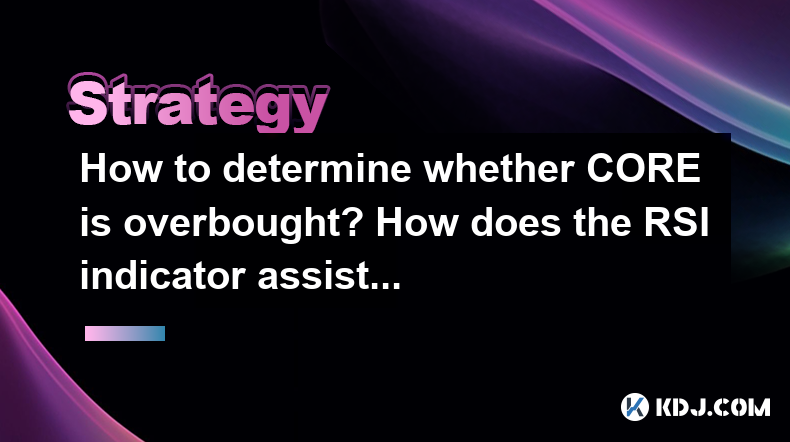-
 bitcoin
bitcoin $122659.385674 USD
0.52% -
 ethereum
ethereum $4484.113342 USD
-0.09% -
 bnb
bnb $1304.229256 USD
-0.85% -
 tether
tether $1.000204 USD
-0.03% -
 xrp
xrp $2.860636 USD
-0.51% -
 solana
solana $227.288799 USD
2.36% -
 usd-coin
usd-coin $0.999805 USD
0.01% -
 dogecoin
dogecoin $0.252837 USD
1.18% -
 tron
tron $0.341149 USD
1.12% -
 cardano
cardano $0.830507 USD
0.33% -
 hyperliquid
hyperliquid $45.792319 USD
0.04% -
 chainlink
chainlink $22.422164 USD
1.55% -
 ethena-usde
ethena-usde $1.000283 USD
0.01% -
 sui
sui $3.511389 USD
0.83% -
 stellar
stellar $0.385276 USD
-0.44%
How to determine whether CORE is overbought? How does the RSI indicator assist in decision-making?
Use RSI to check if CORE is overbought: if RSI > 70, consider selling; if < 30, consider buying. Combine with other indicators for better decisions.
May 07, 2025 at 09:42 am

In the world of cryptocurrency, understanding market indicators is crucial for making informed trading decisions. One such indicator is the Relative Strength Index (RSI), which can help determine whether a cryptocurrency like CORE is overbought. This article will guide you through the process of using the RSI to assess if CORE is overbought and how this indicator can assist in your decision-making process.
Understanding the RSI Indicator
The Relative Strength Index (RSI) is a momentum oscillator that measures the speed and change of price movements. Developed by J. Welles Wilder, it is typically used to identify overbought or oversold conditions in a market. The RSI is calculated based on the average gain and loss of an asset over a specific period, usually 14 days.
To calculate the RSI, the following steps are involved:
- Calculate the average gain and average loss over the selected period.
- Compute the relative strength (RS) by dividing the average gain by the average loss.
- Use the RS to calculate the RSI using the formula: RSI = 100 - (100 / (1 + RS)).
The RSI value ranges from 0 to 100. A value above 70 is generally considered to indicate that an asset is overbought, while a value below 30 suggests it is oversold.
Applying RSI to CORE
To determine whether CORE is overbought using the RSI, you will need to follow these steps:
- Select a reliable cryptocurrency trading platform that offers technical analysis tools, such as Binance, Coinbase, or TradingView.
- Navigate to the CORE trading pair you are interested in, such as CORE/BTC or CORE/USDT.
- Access the RSI indicator on the platform. Most platforms have this indicator readily available in their charting tools.
- Set the RSI period to 14 days, which is the standard period used by most traders.
- Observe the RSI value on the chart. If the RSI is above 70, CORE may be considered overbought.
Interpreting RSI Values for CORE
When the RSI value for CORE is above 70, it suggests that the cryptocurrency has experienced significant upward momentum and may be due for a price correction. This could be an indication to consider selling or taking profits.
Conversely, if the RSI value is below 30, it indicates that CORE may be oversold, and the price could potentially rebound. This might be a signal to consider buying or accumulating more CORE.
However, it is important to note that the RSI should not be used in isolation. It is best used in conjunction with other technical indicators and fundamental analysis to make more informed trading decisions.
Using RSI for Decision-Making
The RSI can be a valuable tool in your decision-making process for trading CORE. Here are some ways to use the RSI effectively:
- Identify potential entry and exit points: If the RSI indicates that CORE is overbought, you might consider selling or taking profits. If it indicates that CORE is oversold, you might consider buying.
- Confirm trends: The RSI can help confirm whether a trend in CORE's price is strong or weakening. For instance, if CORE's price is rising and the RSI remains below 70, it suggests a strong upward trend.
- Detect divergences: Sometimes, the RSI can diverge from the price action of CORE. A bearish divergence occurs when CORE's price makes a higher high, but the RSI makes a lower high, indicating weakening momentum. A bullish divergence occurs when CORE's price makes a lower low, but the RSI makes a higher low, suggesting potential upward momentum.
Practical Example of Using RSI with CORE
Let's consider a practical example of how you might use the RSI to trade CORE:
- Scenario: You notice that the RSI for CORE has reached 75, indicating an overbought condition.
- Action: You decide to sell a portion of your CORE holdings to take profits, as the RSI suggests that a price correction may be imminent.
- Monitoring: You continue to monitor the RSI and CORE's price. A few days later, the RSI drops to 60, and CORE's price experiences a slight correction.
- Re-evaluation: You assess whether the correction is over and if it might be a good time to re-enter the market. If the RSI starts to rise again and remains below 70, it could indicate a good opportunity to buy back into CORE.
Combining RSI with Other Indicators
While the RSI is a powerful tool, combining it with other indicators can provide a more comprehensive view of CORE's market conditions. Here are some other indicators you might consider:
- Moving Averages: These can help identify trends and potential support and resistance levels.
- MACD (Moving Average Convergence Divergence): This can help confirm trend changes and momentum shifts.
- Bollinger Bands: These can provide insights into volatility and potential price breakouts.
By using the RSI in conjunction with these indicators, you can make more informed decisions about whether CORE is overbought and what actions to take.
Frequently Asked Questions
Q: Can the RSI be used for all cryptocurrencies, or is it specific to CORE?A: The RSI is a versatile indicator that can be applied to any cryptocurrency, not just CORE. It works the same way across different assets, providing insights into overbought and oversold conditions based on price momentum.
Q: How often should I check the RSI for CORE?A: The frequency of checking the RSI depends on your trading strategy. For short-term traders, checking the RSI multiple times a day might be necessary. For long-term investors, checking it daily or weekly might be sufficient.
Q: Are there any limitations to using the RSI for CORE?A: Yes, there are limitations to using the RSI. It can generate false signals in strong trending markets, where an asset might remain overbought or oversold for extended periods. Additionally, the RSI should not be used in isolation but combined with other indicators and fundamental analysis for more reliable results.
Q: Can the RSI help predict price movements for CORE?A: The RSI can provide insights into potential price movements by identifying overbought and oversold conditions. However, it does not predict future price movements with certainty. It is one of many tools that traders use to make informed decisions.
Disclaimer:info@kdj.com
The information provided is not trading advice. kdj.com does not assume any responsibility for any investments made based on the information provided in this article. Cryptocurrencies are highly volatile and it is highly recommended that you invest with caution after thorough research!
If you believe that the content used on this website infringes your copyright, please contact us immediately (info@kdj.com) and we will delete it promptly.
- Fan Tokens, Serie A, and Collapses: A New Era or a False Start?
- 2025-10-09 22:25:15
- MoonBull Presale Heats Up Amid ASTER & WLFI Market Moves: The 100x Crypto Opportunity?
- 2025-10-09 22:45:16
- Unlocking the Secrets: Royal Mint Coins and the Stories They Tell
- 2025-10-09 22:45:16
- Strategy, Fixed Income, Changes: Navigating the Evolving Digital Asset Landscape
- 2025-10-09 22:50:12
- LEGO Batman 2026: A Legendary Batmobile Collection is Coming!
- 2025-10-09 22:25:15
- Bitcoin's Earning Trend: Are Holders Missing Out?
- 2025-10-09 22:30:01
Related knowledge

Practical parameter settings for a Bitcoin multi-timeframe moving average system
Sep 18,2025 at 10:54pm
Optimizing Timeframe Combinations for Bitcoin Trading1. Selecting appropriate timeframes is crucial when building a multi-timeframe moving average sys...

How can I filter out false breakouts in Dogecoin high-frequency trading?
Sep 22,2025 at 01:00am
Understanding False Breakouts in Dogecoin Trading1. A false breakout occurs when Dogecoin's price appears to move beyond a defined support or resistan...

Techniques for identifying tops and bottoms in the Bitcoin on-chain NVT model
Sep 20,2025 at 07:54pm
Understanding the NVT Model in Bitcoin Analysis1. The Network Value to Transactions (NVT) ratio is often described as the 'P/E ratio' of the cryptocur...

What does the surge in open interest in Bitcoincoin futures mean?
Sep 20,2025 at 11:18pm
Understanding the Surge in Dogecoin Futures Open Interest1. A surge in open interest within Dogecoin futures indicates a growing number of active cont...

How can I use the Ethereum USDT premium to gauge market sentiment?
Sep 18,2025 at 11:55pm
Understanding the Ethereum USDT Premium1. The Ethereum USDT premium refers to the price difference between USDT (Tether) traded on Ethereum-based plat...

What should I do if Ethereum staking yields decline?
Sep 20,2025 at 06:18am
Understanding the Causes Behind Declining Ethereum Staking Yields1. The Ethereum network transitioned to a proof-of-stake consensus mechanism with the...

Practical parameter settings for a Bitcoin multi-timeframe moving average system
Sep 18,2025 at 10:54pm
Optimizing Timeframe Combinations for Bitcoin Trading1. Selecting appropriate timeframes is crucial when building a multi-timeframe moving average sys...

How can I filter out false breakouts in Dogecoin high-frequency trading?
Sep 22,2025 at 01:00am
Understanding False Breakouts in Dogecoin Trading1. A false breakout occurs when Dogecoin's price appears to move beyond a defined support or resistan...

Techniques for identifying tops and bottoms in the Bitcoin on-chain NVT model
Sep 20,2025 at 07:54pm
Understanding the NVT Model in Bitcoin Analysis1. The Network Value to Transactions (NVT) ratio is often described as the 'P/E ratio' of the cryptocur...

What does the surge in open interest in Bitcoincoin futures mean?
Sep 20,2025 at 11:18pm
Understanding the Surge in Dogecoin Futures Open Interest1. A surge in open interest within Dogecoin futures indicates a growing number of active cont...

How can I use the Ethereum USDT premium to gauge market sentiment?
Sep 18,2025 at 11:55pm
Understanding the Ethereum USDT Premium1. The Ethereum USDT premium refers to the price difference between USDT (Tether) traded on Ethereum-based plat...

What should I do if Ethereum staking yields decline?
Sep 20,2025 at 06:18am
Understanding the Causes Behind Declining Ethereum Staking Yields1. The Ethereum network transitioned to a proof-of-stake consensus mechanism with the...
See all articles


























![🚨IS VECHAIN (VET) A DEAD COIN ?? PRICE ANALYSIS [GET READY NOW] 🚨IS VECHAIN (VET) A DEAD COIN ?? PRICE ANALYSIS [GET READY NOW]](/uploads/2025/10/09/cryptocurrencies-news/videos/vechain-vet-dead-coin-price-analysis-ready/68e7b200b067b_image_500_375.webp)















































